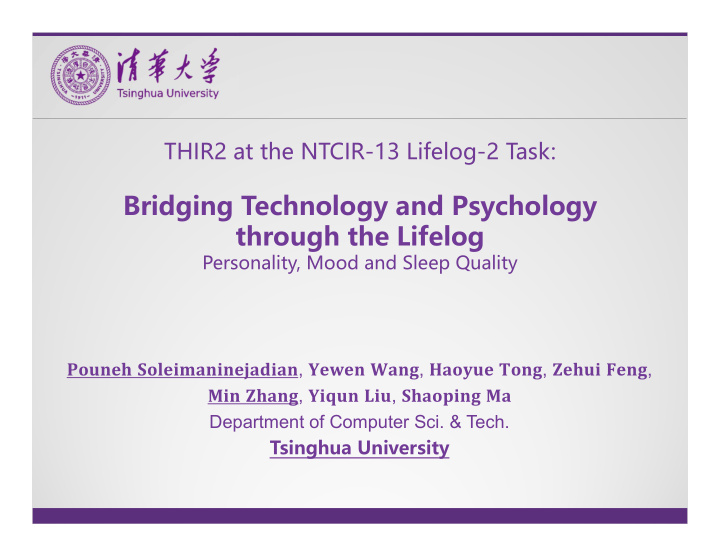



THIR2 at the NTCIR-13 Lifelog-2 Task: BridgingTechnologyandPsychology throughtheLifelog Personality, Mood and Sleep Quality ������ ����������������� , ����� ���� , ������ ���� , ����� ���� , ��� ����� , ����� ��� , �������� �� Department of Computer Sci. & Tech. Tsinghua University
Outline Introduction Big Five Personality Traits Measurement Mood Prediction Music Mood and Style Detection Sleep Quality Prediction Visualization and Insights Summary Future Works
Introduction Fromphysicalworldtopsychologicalworld. Understand and model the life-logger in 4 psychological categories: 1. Study of big five personality traits 2. User mood detection Arousal, Valence 3. Music mood and style detection Music records in the users' history 4. Sleep quality prediction
Introduction Backgroundknowledge Thayer ’ s2DModelofMood Applied in: Big 5 personality eval. User mood detection Music mood detection
Outline Introduction BigFivePersonalityTraitsMeasurement MoodPrediction MusicMoodandStyleDetection SleepQualityPrediction VisualizationandInsights Summary Future Works
1-BigFivePersonalityEvaluation Lifeloginsteadofquestionnaires Big5: Openness to experience, Conscientiousness, Extraversion, Agreeableness, Neuroticism Self-collectedLifelogData Features 40 participants, 3 days‘ lifelog data Gender Label: NEO-FFI (traditional Moody index questionnaire-based test) results Optimistic index Heart rate and Mood record (Nervous, Heart rate Stability Angry, Excited, Pleased, Relaxed, Room tidiness Index Calm, Sad and Bored) Room decorative index Panoramic images of office and bedroom everyday
1-BigFivePersonalityEvaluation Lifeloginsteadofquestionnaires 5 logistic regression models for 5 factors Training: 38 samples (20% Cross Val) Test: 2 samples, Test Accuracy: 100% (too small dataset)
2-MoodPrediction Based on Lifeloginsteadofselfsurveys Features Exp. Data: Weekend Both Lifelog-2 user 1 data + Home /Work Both Extended dataset on 5 participants Commuting Both Total Calories Both 256 days of data in total Total Steps Both Model and ExperimentDesign Average HR Both 2 Logistic Regressions for 2 Dimensions Wakeup Time Both Valence, Arousal Sleep Duration Both Sleep Quality Both Training: Test = 9: 1 Average Arousal Arousal TestAccuracy Previous Day Arousal Arousal Mood-Valence: 76% Average Valence Valence Mood- Arousal: 73% Previous Day Valence Valence
3-MusicMoodandStyle Detection Based on Lifeloginsteadoflyrics oraudio Data: Lifelog-2 music record of user 1 763 songs in 45 days Features : Activities, Biometrics, Time stamp Labels: Retrieved from online resources Model, Experiment, Results Data augmentation using retrieved music duration 2 AdaBoost.M1 + Decision Tree Models Training: Test = 8: 2 Accuracy: 85% (Music Mood), 80% (Music Style) Styles: Metal, Jazz, Soul, Pop, Easy Listening, Soundtrack, R&B, Country, New Age, Rock, International, Vocal Pop, Electronic, Folk Moods: Pleased&relaxed: +valence ,Nervous&sad: - valence, Bored&calm: -arousal, Angry&excited: +arousal
4- SleepQuality Prediction Based on timeawarelifelogfeatures insteadof signals during sleep or user survey Data: Features Lifelog-2 both users’ data + Weekend Extended dataset on 5 participants Home /Work 473 days of data in total Commuting Model and ExperimentDesign Total Calories Labels: Poor:0-35; Borderline:36-55; Total Steps Good: 56-100 Average HR Classification with Linear Regression Calories in Time Training: Test = 9: 1 TestAccuracy Steps in Time Sleep Quality Prediction:78% Heart Rate in Time
5-Visualization Visual insights on historical data, and gives insights on user’s psychological life Sleep Quality Music Mood/Style Big‐5 Personality and Biometrics User Mood
Outline Introduction Big Five Personality Traits Measurement Mood Prediction Music Mood and Style Detection Sleep Quality Prediction Visualization and Insights Summary FutureWork
Summary Novel methods to psychologically understand the user and track user’s mental health : Personality evaluations based on objective data Time-saving and can obtain real-time evaluation Mood prediction based on biometrics Using previous mood records of the user Determination of music mood and music style Based on biometrics and physical activities of the audience Sleep quality prediction Based on not sleep signals monitoring but Lifelog before sleep Using time aware features
Future work Enlarge and diversify the sample set Considering more features Make use of culture differences, daily activities, hobbies, age and more environmental features Improve the models Intervention Giving Suggestions to users during the day for better sleep quality and mood
Thank You! Bridging Technology and Psychology through the Lifelog z-m@tsinghua.edu.cn
Recommend
More recommend